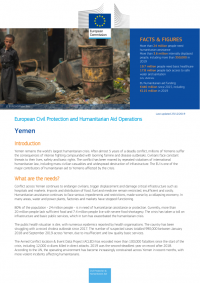ECHO Factsheet – Yemen (Last updated 23/12/2019)
Introduction
Yemen remains the world’s largest humanitarian crisis. After almost 5 years of a deadly conflict, millions of Yemenis suffer the consequences of intense fighting compounded with looming famine and disease outbreaks. Civilians face constant threats to their lives, safety and basic rights. The conflict has been marred by repeated violations of international humanitarian law, including mass civilian casualties and widespread destruction of infrastructure. The EU is one of the major contributors of humanitarian aid to Yemenis affected by the crisis.
What are the needs?
Conflict across Yemen continues to endanger civilians, trigger displacement and damage critical infrastructure such as hospitals and markets. Imports and distribution of food, fuel and medicine remain restricted, insufficient and costly. Humanitarian assistance continues to face serious impediments and restrictions, made worse by a collapsing economy. In many areas, water and power plants, factories and markets have stopped functioning.
80% of the population – 24 million people – is in need of humanitarian assistance or protection. Currently, more than 20 million people lack sufficient food and 7.4 million people live with severe food shortages. The crisis has taken a toll on infrastructure and basic public services, which in turn has exacerbated the humanitarian crisis.
The public health situation is dire, with numerous epidemics reported by health organisations. The country has been struggling with a record cholera outbreak since 2017. The number of suspected cases totalled 990,000 between January 2018 and September 2019 across Yemen, due to insufficient and low quality basic services.
The Armed Conflict location & Event Data Project (ACLED) has recorded more than 100,000 fatalities since the start of the crisis, including 12,000 civilians killed in direct attacks. 2019 was the second-deadliest year on record after 2018. According to the UN, the operating environment has become increasingly constrained across Yemen in recent months, with more violent incidents affecting humanitarians.
How are we helping?
Since the beginning of the conflict in 2015, the European Union has allocated €440 million in humanitarian aid to the Yemen crisis. As of 2019, a total of €115 million has been allocated to humanitarian organisations to support life-saving efforts.
The EU humanitarian aid’s vital assistance includes food, healthcare, education as well as water, shelter and hygiene kits to war-affected areas and displaced populations. EU-funded humanitarian assistance also helps treat severely malnourished children, who are more prone to diseases. To address the cholera epidemic, the EU funds treatment centres and prevention activities. It also supports the emergency outbreak response in areas affected by measles and diphtheria.
Despite access constraints and security challenges, the EU’s humanitarian partners continue to help populations in active war fronts in the north and south, especially those who have suffered physiological and psychological shock. Injured and disabled people, including internally displaced people (IDPs), are assisted with comprehensive rehabilitation services.
Furthermore, the war has negatively impacted Yemen’s already fragile education system. According to the UN, 1 in 5 schools can no longer be used as a direct result of the conflict. The EU supports education projects that aim to rehabilitate classrooms and get children back to school.
In addition, the EU supports the United Nations Humanitarian Air Services (UNHAS), which provides critical and reliable air and sea transport to humanitarian aid workers.
https://reliefweb.int/report/yemen/echo-factsheet-yemen-last-updated-23122019
https://reliefweb.int/sites/reliefweb.int/files/resources/yemen_2020-01-03.pdf

